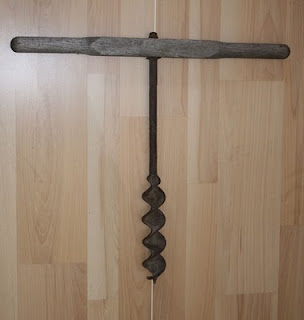Augers were essential tools for drilling holes for pins in barn beams, and for starting mortises to be later opened up and squared using chisels to accept square tenons as illustrated in the diagram below (taken from Eric Sloane, A Museum of Early American Tools, NY: Ballantine, 1964m 1974):
The auger below has a very simple handle:
The next auger below is more advanced, having a forged eye and is stamped “Wm Greaves & Sons, Sheafworks.” William Greaves was in business beginning in 1780 and his sons joined the firm in 1816. The Sheafworks, built in 1825, was the first integrated steel works in Sheffield, England, in which iron went from ingot to finished product. This information dates this auger between 1825 and about 1858.
The auger below was designed to quickly enable the user to change bits.
The auger below is the most sophisticated, operating like a modern tap wrench, and was probably used for more sophisticated purposes such as by a shipwright. It is stamped “Douglas” likely referring to the Douglas Manufacturing Company which made such products at Seymour, Connecticut beginning in 1856 and following their purchase by the James Swan Company in 1877.






No comments:
Post a Comment